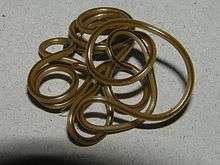Enoplea
Enoplea (enopleans) is a class, which with the classes Secernentea[1] and Chromadorea make up the phylum Nematoda in current taxonomy.[2][3][4] The Enoplea are considered to be a more ancestral group than the Chromadorea, and researchers have referred to its members as the "ancestrally diverged nematodes", compared to the "more recently diverged nematodes" of Chromadorea.[5]
| Enoplea | |
|---|---|
 | |
| Mermis nigrescens | |
| Scientific classification | |
| Kingdom: | Animalia |
| Phylum: | Nematoda |
| Class: | Enoplea Inglis, 1983 |
| Subclasses | |
Description
The Enoplea are distinguished from the Chromadorea by a number of characteristics. The enoplean esophagus is cylindrical or "bottle-shaped", compared to the bulbous chromadorean esophagus. Enopleans have pocket-like amphids, while chromadoreans have amphids shaped like slits, pores, coils, or spirals. An enoplean is smooth or marked with fine lines, while a chromadorean may have rings, projections, or setae. The enoplean excretory system is simple, sometimes made up of a single cell, while chromadoreans have more complex, tubular systems, sometimes with glands.[6][7]
Taxonomy
Phylogenetic analysis of phylum Nematoda suggests three distinct basal clades, the dorylaims, enoplids and chromadorids.[8] These represent Clades I, II and C+S of Blaxter (1998).[9] Of these, the first two appear to have sister clade status, allowing resolution into two classes, Enoplea and Chromadorea, and division of the former into two subclasses corresponding to Clades I and II respectively, the Enoplia and Dorylaimia.
Subdivision
Two subclasses are divided into orders.[6][8][10]
- Subclass Enoplia
- Order Enoplida
- Order Trefusiida
- Order Triplonchida
- Subclass Dorylaimia
- Order Dorylaimida
- Order Mermithida
- Order Mononchida
- Order Dioctophymatida
- Order Trichinellida
- Order Isolaimida
- Order Muspiceida
- Order Marimermithida
Ecology
Several orders of enopleans are mainly freshwater animals, and several include marine species.[11]
Many enopleans are parasites of plants and animals, including humans. The orders Triplonchida and Dorylaimida include plant-parasitic nematodes that are vectors of plant pathogens. The orders Mermithida and Marimermithida include parasites of invertebrates. The orders Dioctophymatida, Trichinellida, and Muspiceida include parasites of vertebrates such as birds and mammals. Examples are Trichinella spiralis, a nematode known for causing trichinosis in humans who consume it in undercooked pork, Haycocknema perplexum which can be life-threatening to humans,[12] and whipworms (genus Trichuris), which are parasites of mammals, including cats, dogs, and humans.[6]
References
- Tree of Life Web Project (ToL) (2002): Nematoda. Version of January 1, 2002. Retrieved November 2, 2008.
- Phylum Nematoda. Nemaplex: Nematode-Plant Expert Information System. University of California, Davis. Version October 4, 2012.
- Jühling, F.; et al. (2012). "Armless mitochondrial tRNAs in Enoplea (Nematoda)". RNA Biology. 9 (9): 1161–66. doi:10.4161/rna.21630. PMC 3579883. PMID 23018779.
- Hyman, B. C.; et al. (2011). "Rampant gene rearrangement and haplotype hypervariation among nematode mitochondrial genomes". Genetica. 139 (5): 611–15. doi:10.1007/s10709-010-9531-3. PMC 3089818. PMID 21136141.
- Schulze, J.; Schierenberg, E. (2009). "Embryogenesis of Romanomermis culicivorax: An alternative way to construct a nematode". Developmental Biology. 334 (1): 10–21. doi:10.1016/j.ydbio.2009.06.009. PMID 19523940.
- Class Enoplea. Nemaplex: Nematode-Plant Expert Information System. University of California, Davis. Version October 9, 2012.
- Class Chromadorea. Nemaplex: Nematode-Plant Expert Information System. University of California, Davis. Version October 4, 2012.
- Lee 2010, p. 13.
- Blaxter 1998.
- Zhang 2011, p. 63.
- Tahseen, Q (2012). "Nematodes in aquatic environments: adaptations and survival strategies" (PDF). Biodiversity Journal. 3 (1): 13–40.
- Basuroy, Ron; Pennisi, Robert (February 2008). "Parasitic myositis in tropical Australia". Medical Journal of Australia. 188 (4): 254–256. doi:10.5694/j.1326-5377.2008.tb01601.x. Retrieved 10 December 2017.
Bibliography
- Lee, Donald L, ed. (2010). The biology of nematodes. London: Taylor & Francis. ISBN 978-0415272117. Retrieved 16 December 2014.CS1 maint: ref=harv (link)
- Zhang, Zhi-Qiang, ed. (2011). Animal biodiversity : an outline of higher-level classification and survey of taxonomic richness. Auckland, N.Z.: Magnolia Press. ISBN 978-1869778491. Retrieved 15 December 2014.CS1 maint: ref=harv (link)
- Blaxter, Mark L.; De Ley, Paul; Garey, James R.; Liu, Leo X.; Scheldeman, Patsy; Vierstraete, Andy; Vanfleteren, Jacques R.; Mackey, Laura Y.; Dorris, Mark; Frisse, Linda M.; Vida, J. T.; Thomas, W. Kelley (5 March 1998). "A molecular evolutionary framework for the phylum Nematoda". Nature. 392 (6671): 71–75. doi:10.1038/32160. PMID 9510248.
| Wikimedia Commons has media related to Enoplea. |
| Wikispecies has information related to Enoplea |